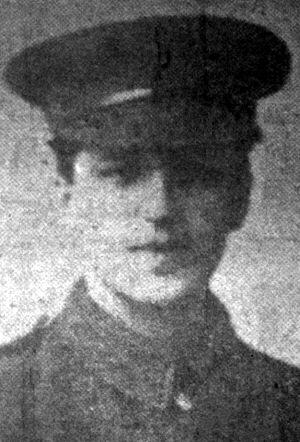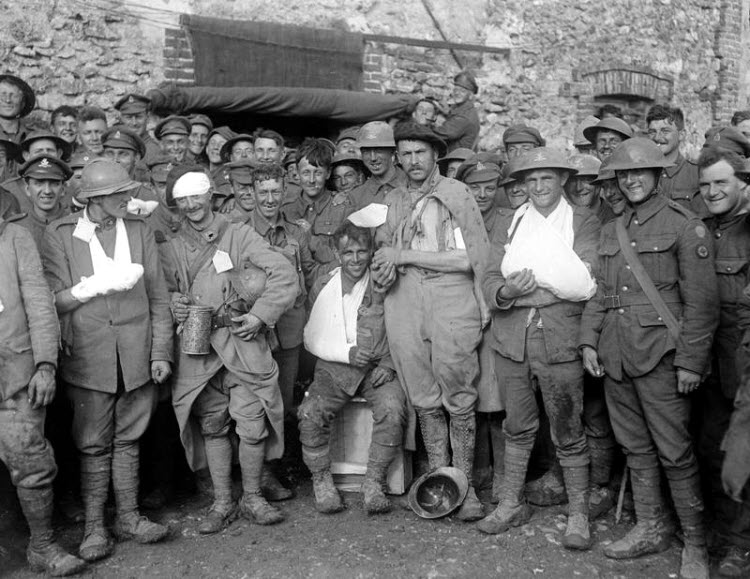
Norman Wainwright was born in Ossett in late 1895, the son of Eli Wainwright and his wife Sarah Ann (nee Hey) who had married in Ossett in 1878. In 1901, the Wainwright family were living in Town End, Ossett and Eli Wainwright was then 44 years of age. There were four brothers in the family: Harvey, Alfred, Freddie and Norman Wainwright and three of them served in WW1 with Harvey and Norman losing their lives. A third member of the Ossett Wainwright family, Wilfred Wainwright, a cousin to Norman and Harvey also lost lost his life in WW1.
By 1911, the Wainwright family was living at 1, Spurr’s Yard, Dale Street, Ossett. Norman was actually one of eight children, but three had died before 1911. In the 1911 census, Norman’s father has unusually revealed that he is suffering from “pleurisy of the kidneys” and he died later that year in the June quarter of 1911. Norman was working as a butcher’ assistant in 1911 and his elder brother Harvey Wainwright (born 1882) was married and living in Westfield Street, Ossett.
Norman Wainwright enlisted in the 2nd/4th Battalion of the King’s Own Yorkshire Light Infantry as a volunteer in February 1915. The Territorial 2nd/4th Battalion, KOYLI was formed at Wakefield on the 30th September 1914 as a second line unit. On the 1st March 1915 they moved to Bulwell and were attached to 187th Brigade in 62nd (2nd West Riding) Division. They moved in April 1915 to Strensall and in May to Beverley, going on in November to Gateshead, January 1916 to Larkhill and June 1916 to Flixton Park near Bungay. They moved again in October 1916 to Wellingborough and landed at Le Havre on 15 January 1917.
Norman Wainwright died in the Battle of Tardenois, which raged from July 20th to the July 31st 1918. As part of 187th Brigade, 62 (West Riding) Division, the 2nd/4th KOYLI were heavily involved.
On 19 July, the Italian Corps lost 9,334 officers and men out of a total fighting strength of about 24,000. Nevertheless, Berthelot rushed two newly arrived British infantry divisions, the 51st (Highland) and 62nd (West Riding), through the Italians straight into attack down the Ardre Valley. The plan was for XXII Corps to attack down the Ardre valley at 8 a.m. on the 20th July 1918 with 51 Division on the left-side of the river and 62 Division on the right. 62 Division’s start line was Pourcy to Bois de Pourcy. French and Italian artillery were to support them.
Above the start line, the valley was heavily wooded and difficult to penetrate, while below, it was 2 to 3 km wide with corn-fields near the river and enclosed by steep, heavily wooded hills each side. The attack began on time, and after a hard day’s fighting Courmas had been captured, and the XXII corps front passed just east of Espilly, Marfaux and Cuitron, thence through the woods, west of Courmas and on to the cross-roads between Bouilly and Onrézy.
On July 20th the 2/4th York and Lancasters, on the extreme right of the British line, captured Bouilly, but were driven out again. At the same time the 5th Yorkshire Light Infantry was held up and lost heavily in front of the Château of Commetreuil. It was a long, difficult, and expensive day for the 187th Brigade, and its only remaining battalion, the 2/4th Yorkshire Light Infantry, lost heavily as well.1
The Germans ordered a retreat on the 20th of July and were forced back to the positions from which they had started their Spring Offensives. They strengthened their flank positions opposite the Allied pincers and on the 22nd, Ludendorff ordered to take up a line from the upper Ourcq to Marfaux.

Above: Some of the “lucky” British soldiers who survived the Battle of Tardenois in July 1918.
The “Ossett Observer” 2 had this obituary for Lance-Corporal Norman Wainwright:
“Local war casualties reported this week include the name of Lance-corporal Norman Wainwright (22), King’s Own Yorkshire Light Infantry, whose widowed mother resides at Headlands, Ossett. Intimation has been received that he was killed in action on July 20th. He joined the army in February 1915 and at that time was employed by Messrs. Archer and Radley, pork butchers, Market-place. He had much experience of the fighting, and had been wounded twice previously, and gassed once. It is about four months since he last returned to France. A brother of his met his death in the war zone some time ago, and another brother is serving in the army.”
Lance-Corporal Norman Wainwright died on the 20th July 1918 at the age of 23, the son of Sarah Ann Wainwright, of 7, Headlands, Ossett. He was awarded the British and Victory medals, as well as the 1914/15 Star, having embarked for France on the 25th December 1915.
Lance-Corporal Norman Wainwright is buried at grave reference I. B. 15 at the Bouilly Crossroads Military Cemetery 3, Marne, France. Bouilly is a commune 13 kilometres west of Reims.
The cemetery was created in 1918 by the French Forces to contain British, French, Italian and German soldiers who had fallen in the vicinity. After the Armistice all other nationalities were removed and the cemetery was used for the concentration of British graves from the surrounding area. Most of the casualties who are buried here fell in the Battle of the Marne (18th July-6th August, 1918).
References:
1. “The British Campaign in France and Flanders, Volume 6, July – November 1918”, by Arthur Conan Doyle, Hodder & Stoughton, London, 1920.
2. “Ossett Observer”, August 24th 1918